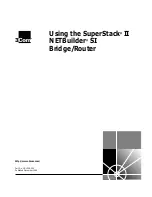
799
Configuring IP Unicast Routing
Configuring IP Addressing
—
A switch virtual interface (SVI): a VLAN interface created by using the
interface vlan
vlan_id
global configuration
command and by default a Layer 3 interface.
—
An EtherChannel port channel in Layer 3 mode: a port-channel logical interface created by using the
interface
port-channel
port-channel-number
global configuration command and binding the Ethernet interface into the
channel group.
The switch does not support tunnel interfaces for unicast routed traffic.
All Layer 3 interfaces on which routing will occur must have IP addresses assigned to them. See
Addresses to Network Interfaces, page 800
A Layer 3 switch can have an IP address assigned to each routed port and SVI. The number of routed ports and SVIs
that you can configure is not limited by software. However, the interrelationship between this number and the number
and volume of features being implemented might have an impact on CPU utilization because of hardware limitations.
To support IPv4 routing, use the
sdm prefer default
global configuration command to set the Switch Database
Management (sdm) feature to balance resources. For more information on the SDM templates, see the
sdm prefer
command in the command reference listed in the
Steps for Configuring Routing
Configuring IPv4 routing consists of several main procedures:
Configure Layer 3 interfaces.
Enable IPv4 routing on the switch.
Assign IPv4 addresses to the Layer 3 interfaces.
Enable selected routing protocols on the switch.
Configure routing protocol parameters (optional).
Configuring IP Addressing
IP routing requires that Layer 3 network interfaces are assigned IP addresses to enable the interfaces and to allow
communication with the hosts on interfaces that use IP. These sections describe how to configure various IP addressing
features. Assigning IP addresses to the interface is required; the other procedures are optional.
Default Addressing Configuration, page 800
Assigning IP Addresses to Network Interfaces, page 800
Configuring Address Resolution Methods, page 803
Routing Assistance When IP Routing is Disabled, page 807
Configuring Broadcast Packet Handling, page 810
Summary of Contents for IE 4000
Page 12: ...8 Configuration Overview Default Settings After Initial Switch Configuration ...
Page 52: ...48 Configuring Interfaces Monitoring and Maintaining the Interfaces ...
Page 108: ...104 Configuring Switch Clusters Additional References ...
Page 128: ...124 Performing Switch Administration Additional References ...
Page 130: ...126 Configuring PTP ...
Page 140: ...136 Configuring CIP Additional References ...
Page 146: ...142 Configuring SDM Templates Configuration Examples for Configuring SDM Templates ...
Page 192: ...188 Configuring Switch Based Authentication Additional References ...
Page 244: ...240 Configuring IEEE 802 1x Port Based Authentication Additional References ...
Page 298: ...294 Configuring VLANs Additional References ...
Page 336: ...332 Configuring STP Additional References ...
Page 408: ...404 Configuring DHCP Additional References ...
Page 450: ...446 Configuring IGMP Snooping and MVR Additional References ...
Page 490: ...486 Configuring SPAN and RSPAN Additional References ...
Page 502: ...498 Configuring Layer 2 NAT ...
Page 770: ...766 Configuring IPv6 MLD Snooping Related Documents ...
Page 930: ...926 Configuring IP Unicast Routing Related Documents ...
Page 976: ...972 Configuring Cisco IOS IP SLAs Operations Additional References ...
Page 978: ...974 Dying Gasp ...
Page 990: ...986 Configuring Enhanced Object Tracking Monitoring Enhanced Object Tracking ...
Page 994: ...990 Configuring MODBUS TCP Displaying MODBUS TCP Information ...
Page 996: ...992 Ethernet CFM ...
Page 1066: ...1062 Using an SD Card SD Card Alarms ...
















































